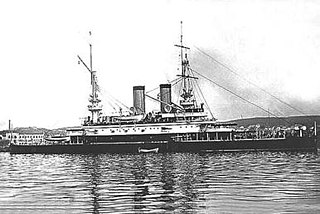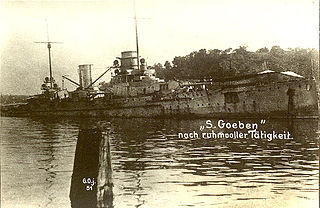
SMS Goeben was the second of two Moltke-class battlecruisers of the Imperial German Navy, launched in 1911 and named after the German Franco-Prussian War veteran General August Karl von Goeben. Along with her sister ship, Goeben was similar to the previous German battlecruiser design, Von der Tann, but larger, with increased armor protection and two more main guns in an additional turret. Goeben and Moltke were significantly larger and better armored than the comparable British Indefatigable class.

The Russian battleship Potemkin was a pre-dreadnought battleship built for the Imperial Russian Navy's Black Sea Fleet. She became famous when the crew rebelled against the officers in June 1905, which is now viewed as a first step towards the Russian Revolution of 1917. The mutiny later formed the basis of Sergei Eisenstein's 1925 silent film Battleship Potemkin.

The Lord Nelson class consisted of a pair of pre-dreadnought battleships built for the Royal Navy in the first decade of the twentieth century. Although they were the last British pre-dreadnoughts, both were completed and commissioned well over a year after HMS Dreadnought had entered service in late 1906. Lord Nelson and Agamemnon were assigned to the Home Fleet when completed in 1908, with the former ship often serving as a flagship. The sister ships were transferred to the Channel Fleet when the First World War began in August 1914. They were transferred to the Mediterranean Sea in early 1915 to participate in the Dardanelles Campaign.

SMS Breslau was a Magdeburg-class cruiser of the Imperial German Navy, built in the early 1910s and named after the Lower Silesian city of Breslau. Following her commissioning, Breslau and the battlecruiser Goeben were assigned to the Mittelmeerdivision in response to the Balkan Wars. After evading British warships in the Mediterranean to reach Constantinople, Breslau and Goeben were transferred to the Ottoman Empire in August 1914, to entice the Ottomans to join the Central Powers in World War I. The two ships, along with several other Ottoman vessels, raided Russian ports in October 1914, prompting a Russian declaration of war. The ships were renamed Midilli and Yavûz Sultân Selîm, respectively, and saw extensive service with the Ottoman fleet, primarily in the Black Sea against the Russian Black Sea Fleet.

Naval warfare in World War I was mainly characterized by blockade. The Allied Powers, with their larger fleets and surrounding position, largely succeeded in their blockade of Germany and the other Central Powers, whilst the efforts of the Central Powers to break that blockade, or to establish an effective counterblockade with submarines and commerce raiders, were eventually unsuccessful. Major fleet actions were less decisive.

The Imperatritsa Mariya-class battleships were the first dreadnoughts built for the Black Sea Fleet of the Imperial Russian Navy. All three ships were built in Nikolayev during World War I; two of the ships were built by the Rossud Dockyard and the third was built by the Associated Factories and Shipyards of Nikolayev. Two ships were delivered in 1915 and saw some combat against ex-German warships that had been 'gifted' to the Ottoman Empire, but the third was not completed until 1917 and saw no combat due to the disorder in the navy after the February Revolution earlier that year.

Imperatritsa Mariya was the lead ship of her class of three dreadnoughts built for the Imperial Russian Navy during World War I. She served with the Black Sea Fleet during the war and covered older pre-dreadnought battleships as they bombarded Ottoman facilities in 1915. The ship engaged the Ottoman light cruiser Midilli,(formerly the German SMS Breslau) several times without inflicting anything more serious than splinter damage. Imperatritsa Mariya was sunk at anchor in Sevastopol by a magazine explosion in late 1916, killing 228 crewmen. She was subsequently raised, but her condition was very poor. She was finally scrapped in 1926, after the end of the Russian Civil War.

Imperatritsa Ekaterina Velikaya was the second of three Imperatritsa Mariya-class dreadnoughts built for the Imperial Russian Navy during World War I. Completed in 1915, she was assigned to the Black Sea Fleet. She engaged the ex-German battlecruiser Yavûz Sultân Selîm once, but only inflicted splinter damage while taking no damage herself. The ship briefly encountered an Ottoman light cruiser, but mostly covered the actions of smaller ships during the war without firing her guns. These included minelaying operations off the Bosporus and anti-shipping sweeps of the coast of Anatolia. Imperatritsa Ekaterina Velikaya was renamed Svobodnaya Rossiya after the February Revolution of 1917.

Tri Sviatitelia was a pre-dreadnought battleship built for the Imperial Russian Navy during the 1890s. She served with the Black Sea Fleet and was flagship of the forces pursuing the mutinous battleship Potemkin in June 1905. During World War I the ship encountered the German battlecruiser SMS Goeben twice, but never hit the German ship, nor was she damaged by her. From 1915 onward she was relegated to the coast bombardment role as she was the oldest battleship in the fleet. Tri Sviatitelia was refitting in Sevastopol when the February Revolution of 1917 began and she was never operational afterwards.
A naval race had developed in the Aegean after the end of the Balkan Wars, with the Ottoman government ordering several ships, including two dreadnoughts, in Britain. In the event, with the outbreak of World War I, these ships, including further two scout cruisers and four destroyers, were confiscated and pressed into service with the Royal Navy. This disappointed the Ottomans, contributing to their joining the Central Powers in the Great War.

The Battle of Cape Sarych was a naval engagement fought off the coast of Cape Sarych in the Black Sea during the First World War. In November 1914, two modern Ottoman warships, specifically a light cruiser and a battlecruiser, engaged a Russian fleet including five obsolescent pre-dreadnought battleships in a short action.

The Battle of Imbros was a naval action that took place during the First World War. The battle occurred on 20 January 1918 when an Ottoman squadron engaged a flotilla of the British Royal Navy off the island of Imbros in the Aegean Sea. A lack of heavy Allied warships in the area allowed the Ottoman battlecruiser Yavûz Sultân Selîm and light cruiser Midilli to sortie into the Mediterranean and attack the Royal Navy monitors and destroyers at Imbros before assaulting the naval base at Mudros.
Evstafi was the lead ship of her class of two pre-dreadnought battleship of the Imperial Russian Navy's Black Sea Fleet. She was built before World War I and her completion was greatly delayed by changes made to reflect the lessons of the Russo-Japanese War of 1905.

Ioann Zlatoust was an Evstafi-class pre-dreadnought battleship of the Imperial Russian Navy's Black Sea Fleet. She was built before World War I and her completion was greatly delayed by changes made to reflect the lessons of the Russo-Japanese War of 1905. She was the second ship of her class.

Berk-i Satvet was a torpedo cruiser of the Ottoman Navy, the second and final member of the Peyk-i Şevket class. She was built by the Germaniawerft shipyard in Germany in 1906–07, and was delivered to the Ottoman Navy in November 1907. The ship's primary armament consisted of three 450 mm (18 in) torpedo tubes and a pair of 105 mm (4.1 in) guns, and she was capable of a top speed of 21 knots. The ship's early career was uneventful; the Italo-Turkish War of 1911–12 passed without any action of the Ottoman fleet. Berk-i Satvet saw action during the Balkan Wars of 1912–13 in the Aegean and Black Seas, against Greek and Bulgarian opponents, respectively.
The action of 10 May 1915 was a naval encounter between the Russian pre-dreadnought squadron and the Ottoman battlecruiser Yavuz Sultan Selim in the Black Sea. After a brief exchange of fire the Ottomans withdrew.

Leytenant Shestakov was a destroyer of the Imperial Russian Navy and the name ship of her class. The ship was built by the Naval Yard, Nikolayev from 1906 to 1909, being launched on 28 July 1908. The ship served in the Russian Black Sea Fleet during the First World War, passing to control of the Bolsheviks following the October Revolution but was scuttled on 18 June 1918 to avoid capture by German troops.
Nümune-i Hamiyet, originally built as SMS S167, was one of the four S138-class torpedo boats built for the German Imperial Navy, but was purchased for the Ottoman Navy during construction.

Samsun was one of the four Durandal-class destroyers purchased by the Ottoman Empire from France in 1907. The ship served in the Ottoman navy during the Tripoli War, the Balkan Wars and World War I.















